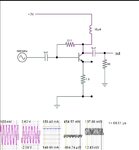neazoi
Advanced Member level 6
Help with 1mw to 100mw uhf TV amplifiers
Hello, these two tv class-a amplifiers are from 2 magazines I have found. Both are said to amplify 1mw uhf tv signal to about 100mw.
the first one is a 4 stage one and the second a 3 stage.
The first one uses bfr91a for the first two transistors and bfr96s for the final two.
The second one uses bfr96s for the first two transistors and bfq34t for the final one.
I was wondering which one of the two would be better to build (i.e works better)?
The second one (3 stage) is simpler but I see that there are no RFCs, could this work ok?
Also if you add the theoretical transistors amplifications you will find that the second one has only about 32db maximum amplification whereas the first one amplification is tested from the magazine and is about 38db. This means that it must be able to amplify signals as low as 16uW, but the magazine states that its input is about 1mw, so probably there is a mistake there. The other thing is that the 3-stage circuit consumes 100mA @ 12v, whereas the 4-stage one consumes 18v @ 500mA. So I believe the 4-stage one can indeed provide an output of 100mW where as the 3-stage one claim of 100mW is false. They both operate in class-a.
What do you think?
Hello, these two tv class-a amplifiers are from 2 magazines I have found. Both are said to amplify 1mw uhf tv signal to about 100mw.
the first one is a 4 stage one and the second a 3 stage.
The first one uses bfr91a for the first two transistors and bfr96s for the final two.
The second one uses bfr96s for the first two transistors and bfq34t for the final one.
I was wondering which one of the two would be better to build (i.e works better)?
The second one (3 stage) is simpler but I see that there are no RFCs, could this work ok?
Also if you add the theoretical transistors amplifications you will find that the second one has only about 32db maximum amplification whereas the first one amplification is tested from the magazine and is about 38db. This means that it must be able to amplify signals as low as 16uW, but the magazine states that its input is about 1mw, so probably there is a mistake there. The other thing is that the 3-stage circuit consumes 100mA @ 12v, whereas the 4-stage one consumes 18v @ 500mA. So I believe the 4-stage one can indeed provide an output of 100mW where as the 3-stage one claim of 100mW is false. They both operate in class-a.
What do you think?
Attachments
Last edited:


